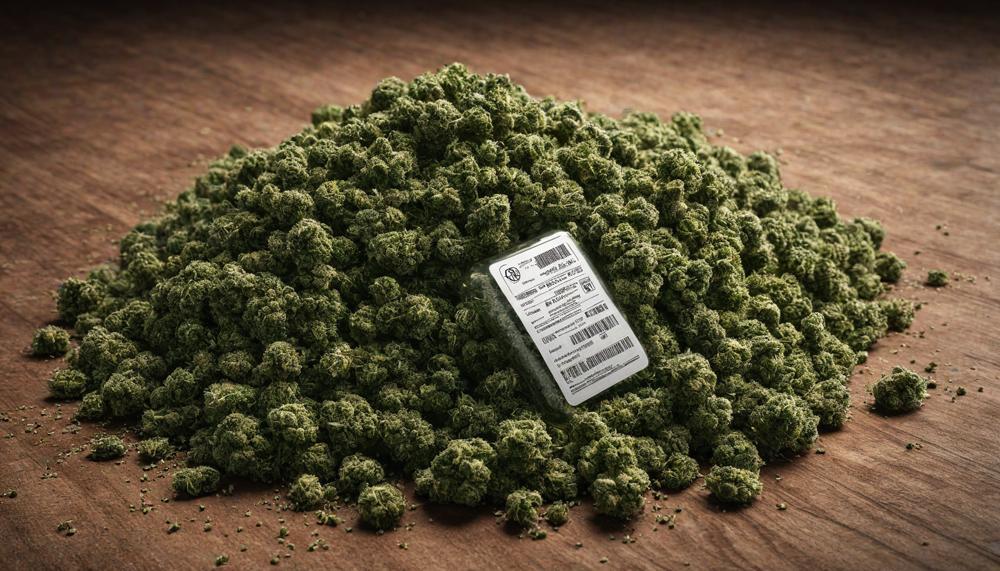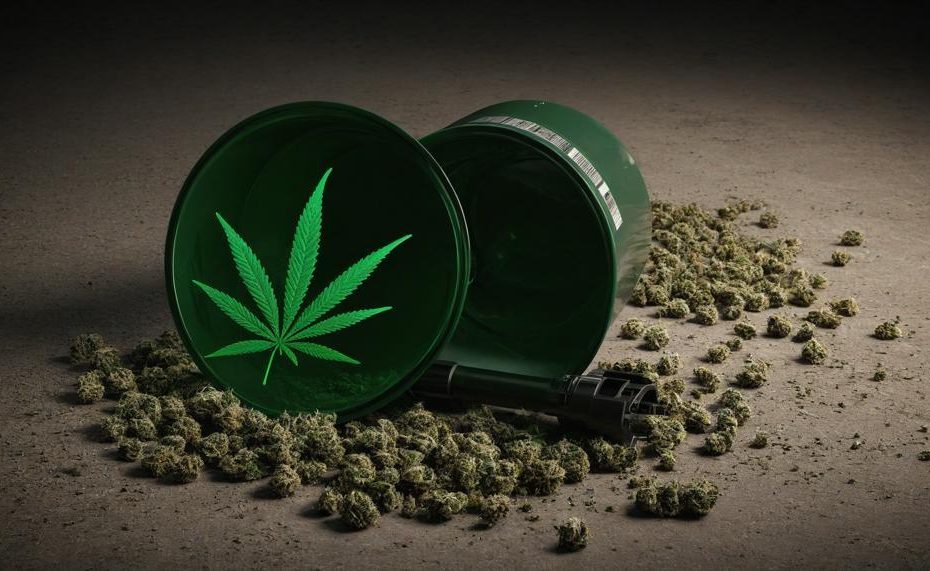Disposing of marijuana properly is crucial for ensuring safety and compliance with regulations. Whether you’re a grower, retailer, or individual, understanding the correct methods can prevent environmental harm and legal issues. Here’s how to do it right:
- Contact a Composting Facility or Waste Collection Authority: These facilities are equipped to handle marijuana waste responsibly.
- Businesses: Must follow strict storage and disposal guidelines to ensure marijuana products are unusable and unrecognizable.
- Individuals: Options include making edibles unrecognizable, taking them to composting facilities, discarding them at airports, or returning them to dispensaries.
- Documentation: In states like California, proper documentation is required for marijuana waste disposal.
Key Takeaways:
- Use composting facilities or waste collection authorities for proper disposal.
- Follow strict guidelines if you’re a business.
- Individuals have multiple disposal options, including returning to dispensaries.
- Ensure marijuana waste is unusable and unrecognizable before disposal.
- Proper documentation is essential in certain states.
By following these steps, you contribute to safe and responsible marijuana use and disposal.
Contents
Key Takeaways
Key Takeaways
The key steps to properly disposing of marijuana involve ensuring safety, compliance with regulations, and reducing environmental impact. Here’s a detailed guide:
| Step | Description | Details |
| Segregation | Separate cannabis waste from other types of waste | Keep cannabis waste in a designated container to avoid contamination with other waste. This helps in maintaining compliance with regulatory standards. |
| Rendering Unusable | Make the marijuana waste unusable and unrecognizable | Mix the marijuana waste with other materials like soil, cat litter, or plastic, ensuring it cannot be used or identified as cannabis. This step is crucial to prevent diversion or misuse. |
| Secure Packaging | Use leak-proof, airtight containers | Package the waste in secure, airtight containers to contain odors and prevent leaks. This minimizes environmental impact and legal issues. |
| Labeling | Clearly label the waste containers | Labels should indicate the contents and status as marijuana waste. This aids in proper handling during storage and transportation. |
| Transportation | Transport to appropriate disposal facilities | Contact local composting facilities or waste collection authorities that accept marijuana waste. Ensure transportation follows local regulations to avoid legal complications. |
| Documentation | Maintain records of the disposal process | Keep detailed records of how the marijuana waste was disposed of, including dates and methods. This is particularly important in regions with stringent regulatory requirements like California. |
| Utilize Free Disposal Services | Take advantage of dispensary disposal services | Some dispensaries offer free services for disposing of marijuana waste. Check with your local dispensary to see if they provide this service. |
| Return or Drop-off | Return unused or expired products to dispensaries or designated drop-off points | If available, return marijuana products to the place of purchase or use designated drop-off points at airports or other locations. |
Understanding Cannabis Waste Regulations
The current regulations for disposing of cannabis waste aim to prevent its diversion and minimise environmental harm. Here’s a detailed breakdown:
| Regulation | Description | Compliance Tips |
| Rendering Waste Unusable | Cannabis waste must be rendered unusable and unrecognizable, typically by mixing it with non-consumable waste (e.g., soil, plastic). | Mix cannabis waste with at least 50% non-consumable material before disposal. |
| Segregation | Different types of cannabis waste (e.g., plant material, packaging) must be segregated to prevent cross-contamination. | Separate waste into categories like plant material, hazardous waste, and general waste. |
| Storage and Labeling | Waste must be stored in secure, labeled containers indicating contents and potential hazards. | Use airtight, clearly labeled containers to prevent odor and ensure safe handling. |
| Transportation | Transport cannabis waste securely, using trained personnel and maintaining proper documentation. | Employ licensed transporters and keep detailed records of waste movement. |
| Disposal | Disposal must occur at licensed facilities equipped to handle cannabis waste safely. | Use state-approved disposal facilities and follow their specific guidelines. |
| Composting | Composting cannabis waste is encouraged for its sustainability, turning waste into nutrient-rich soil. | Ensure composting is permitted in your jurisdiction and follow local composting guidelines. |
To ensure compliance, individuals should follow these steps:
- Segregate Waste: Separate cannabis waste from other types of waste to prevent contamination.
- Make Waste Unusable: Mix cannabis waste with non-consumable materials to render it unusable.
- Secure Storage: Store waste in airtight containers to contain odors and ensure safety.
- Proper Labeling: Clearly label containers with contents and any hazardous properties.
- Use Licensed Facilities: Transport waste to licensed facilities for proper disposal.
- Documentation: Maintain detailed records of waste disposal processes.

Segregation and Separation of Cannabis Waste
Proper segregation and separation of cannabis waste are pivotal to the disposal process, ensuring efficiency, compliance, and sustainability. Here’s how they make a difference:
Regulatory Compliance:
Adhering to stringent local, state, and federal regulations is paramount. By segregating cannabis waste correctly, businesses avoid hefty fines and maintain their operational licenses.
This involves categorizing waste into various types like organic material, hazardous waste, and recyclables, ensuring each is treated according to specific legal requirements.
Environmental Impact:
Segregation enables recycling and composting, significantly reducing the environmental footprint.
Separating recyclable materials such as glass, plastic, and cardboard from organic waste allows for effective recycling processes, while composting organic waste contributes to the creation of nutrient-rich soil amendments. This sustainable practice aids in the conservation of resources and reduction of landfill use.
Cost Efficiency:
Proper segregation can lead to cost savings by minimizing the volume of waste that needs specialized disposal methods, which are often more expensive.
Efficient separation means that only truly hazardous or non-recyclable materials require costly disposal services, while other materials can be processed more economically.
Operational Efficiency:
Streamlining waste management through proper segregation simplifies the disposal process.
By clearly identifying and separating different types of waste, businesses can implement more straightforward and efficient handling procedures, reducing the time and resources spent on waste management.
Education and Awareness:
Educating employees about the importance of waste segregation fosters a culture of responsibility and sustainability within the organization.
Training staff to distinguish between different types of waste ensures that segregation happens effectively at every stage of the cannabis production process.
Partnerships with Disposal Companies:
By segregating waste properly, businesses can form more effective partnerships with cannabis waste disposal companies.
Clear separation of waste types allows these companies to apply the most suitable disposal methods, ensuring that waste is handled in an environmentally responsible and compliant manner.
Long-term Sustainability:
Implementing robust segregation practices contributes to the long-term sustainability of the cannabis industry.
It supports the development of a greener, more environmentally responsible business model that not only meets regulatory requirements but also aligns with broader societal goals for sustainability.
Proper Storage and Labeling of Cannabis Waste
Ensuring the proper storage and labeling of cannabis waste is critical for compliance, safety, and environmental protection. Here’s a comprehensive guide to handle this effectively:
| Storage Requirements | Labeling Requirements | Compliance Tips |
|
|
|
By following these storage and labeling guidelines, facilities can ensure the safe and compliant disposal of cannabis waste. For further information, check local regulations and consult with licensed disposal services.
Implementing Secure Transportation for Cannabis Waste
To ensure cannabis waste is disposed of properly and securely, several measures should be taken. Here’s a detailed guide:
- Compliance with Regulations: Familiarise yourself with local and state regulations for cannabis waste disposal to ensure compliance and prevent diversion. Regulations vary, so check with the relevant authorities.
- Segregation of Waste: Segregate different types of cannabis waste, such as plant material, contaminated products, and hazardous waste. This prevents cross-contamination and promotes efficient disposal.
- Secure Packaging: Use secure, tamper-evident packaging to transport cannabis waste. Ensure containers are airtight to contain odors and prevent leaks, which can lead to legal and environmental issues.
- Proper Labeling: Clearly label all containers with required information, including contents, hazardous properties, and origin. Labels should be durable and legible.
- Trained Personnel: Only trained and certified personnel should handle and transport cannabis waste. They must understand handling procedures, safety protocols, and emergency measures.
- Storage Conditions: Store cannabis waste in a cool, dry place before transportation to prevent mold growth and maintain the integrity of the waste.
- Documentation and Tracking: Maintain detailed records of the waste, including quantity, type, source, and disposal method. Implement a tracking system to monitor the transportation process and ensure accountability.
- Transportation Security: Use secure vehicles equipped with locks and GPS tracking to prevent theft or diversion during transportation. Plan routes to avoid residential areas and ensure prompt disposal.
Disposal Methods for Cannabis Waste
The most environmentally friendly methods for disposing of cannabis waste involve composting, anaerobic digestion, and proper segregation and recycling of materials. Here are some detailed explanations of these methods:
Composting
Composting is a highly sustainable method. It transforms organic cannabis waste into nutrient-rich soil.
This process reduces landfill usage and returns valuable nutrients to the earth, promoting a circular economy.
Anaerobic Digestion
Anaerobic digestion involves breaking down cannabis waste in an oxygen-free environment.
This method not only manages waste but also produces biogas, a renewable energy source, and digestate, which can be used as a fertilizer.
Proper Segregation and Recycling
Segregating cannabis waste, such as plastics, metals, and organic materials, ensures that recyclable materials are properly processed. This reduces overall waste and promotes the reuse of resources.
Conclusion
Proper disposal of marijuana is pivotal for safety, regulatory compliance, and environmental protection. This guide distills the essential steps for growers, retailers, and individuals to handle marijuana waste responsibly.
Firstly, utilizing composting facilities or waste collection authorities ensures that marijuana waste is processed in an environmentally friendly manner. Businesses must adhere to strict storage and disposal regulations, rendering marijuana products unusable and unrecognizable. This can involve mixing with soil, cat litter, or plastic, ensuring they cannot be repurposed or identified.
For individuals, options include returning unused products to dispensaries, taking them to composting facilities, or disposing of them at designated drop-off points, such as airports. Proper documentation is critical, especially in states like California, where detailed records of the disposal process are mandatory.
Segregating different types of cannabis waste, securing them in airtight containers, and clearly labeling these containers with necessary information ensures safety and compliance. Additionally, employing licensed facilities and maintaining thorough records of the disposal process are crucial steps.
By following these practices, you contribute to a safer environment and help maintain the integrity of regulatory standards.





